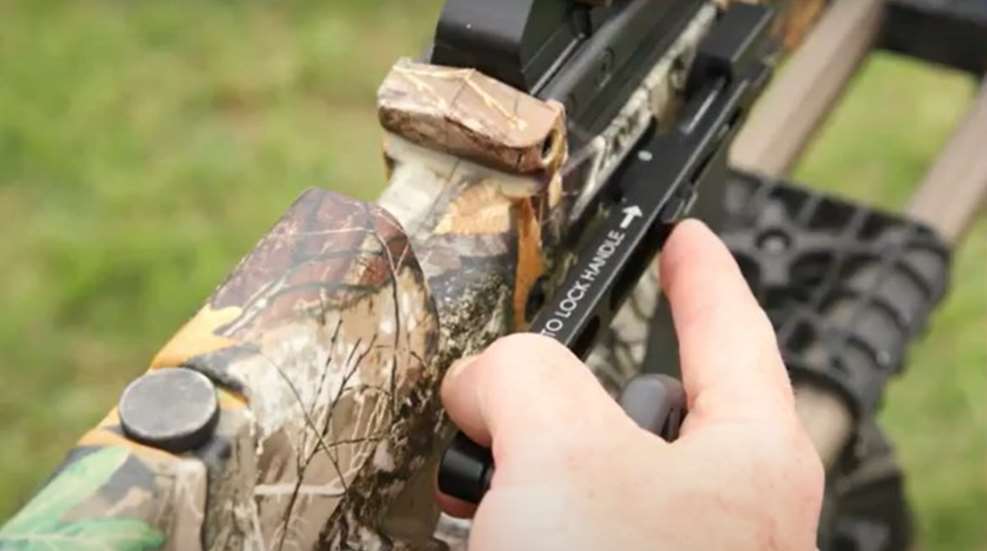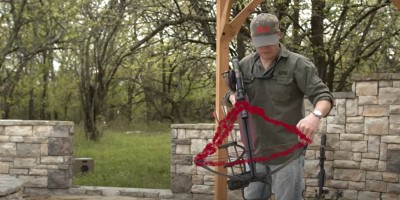
There’s just something inherently scary-looking about a cocked crossbow. I don’t know--maybe it’s because it resembles a human-sized mouse trap; or perhaps because it’s got more cables, pulleys and sharp edges than a guillotine. Reality is, however, a crossbow is just a tool like any other--certainly no more dangerous if misused than a gun, a car or a power saw. There’s no need to worry provided you load, unload and handle it correctly. Here’s how.
1. Loading a Crossbow
Loading consists of two phases--cocking and loading--and really there’s only three things you must remember while doing so.
- Always keep the crossbow pointed in a safe direction.
- Always keep your finger off the trigger, your hands and fingers under the flightdeck and out of the "danger triangle."
- Always keep the crossbow uncocked and unloaded until ready to use.
Just with as with guns, if you abide by these rules, no one will get hurt even if there is a mishap.
Pictured: "danger triangle." For a better view, there's a video at the end of this article!
Step 1: Cocking
Because there are many crossbows on the market that must be cocked in various ways, it’s impossible to go into specifics here; but the concept remains the same for all of them: The crossbow’s string must be pulled back until it engages the fire control mechanism that holds the string back (or cocked) until the trigger is pulled.
Most crossbows utilize a foot stirrup, that, when the crossbow is pointed down and rested on the ground, allows you to use your foot to pin the crossbow to the ground so that the string can be pulled back with two hands.
Newer and higher-end crossbows these days often have a incremental crank-cocking mechanism--almost like a boat-trailer winch--that drastically reduces the strength needed to cock them. If your crossbow has a crank device, you must read the owner’s manual for the proper cocking technique.
Regardless, in cocking any crossbow, there are really only three dangers to avoid: 1. Keep your hands and fingers on either side of the barrel as you draw the string back, so they cannot become pinched in the firing mechanism. 2. Keep your foot firmly on the stirrup so the bow cannot recoil backward and strike you in the face or chest midway through the cocking stroke. 3. Pull with your arms and shoulders--and not with your back--to avoid spinal injuries.
Finally, when pulling the string back, make sure it’s pulled vigorously backward as far as it can go. Failing to do so, or “short stroking,” can lead to a tricky situation wherein the bow is not fully cocked but the automatic safety is engaged, therefore rendering the bow incapable of firing or being let down without manual manipulation. But more on this later. Once the crossbow is cocked, all there is left to do is load the bolt.
Step 2: Loading
Loading the crossbow simply consists of placing an arrow on the cocked crossbow’s barrel, or flight deck, and making sure its nock contacts the string.
First, grasp the arrow immediately behind its tip or broadhead to load it on the barrel with your hand never going past the string’s powerstroke (the string’s path when it’s released) or the arrow’s flight path. The goal here is to position your hand behind the broadhead but in front of the crossbow’s cams so that if the bow went off accidentally, your hand wouldn’t be harmed by the arrow’s point or the string.
Typically the arrow should be oriented with its cock vane (the odd-colored vane) down so it rides in the barrarl’s channel. While keeping the crossbow pointed in a safe direction, lay the arrow on the barrel and using your fingers to push it toward the string in short increments so your hand is never exposed to danger. As the arrow’s nock nears the string under the crossbow’s fire control housing, give the arrow a firm push to make sure it overcomes the bow’s anti-dry fire device and contacts the bowstring. You never want space between the string and the arrow when the bow is fired.
As soon as the arrow is loaded, you’re ready to shoot. Just make sure your thumbs and fingers never stick above the flight deck and that nothing--including your rope cocker, a necklace, game call or anything else falls inside the cocked crossbow’s danger triangle when shooting.
2. Unloading the Crossbow
Many times during a hunt, a crossbow is loaded in anticipation of firing, but the shot opportunity never materializes. So rather than driving home with a cocked and loaded crossbow, the crossbow should, of course, be unloaded and uncocked after each hunt.
The best way to unload and uncock any crossbow is to shoot it--but firing it without an arrow loaded (called "dry-firing") will almost surely destroy the crossbow and can be very dangerous to the shooter. So the bow should be unloaded by firing an actual arrow. But who wants to dull an expensive broadhead or risk losing an expensive arrow? Therefore it’s best to either carry a practice arrow on your crossbow’s quiver that can be fired at a target without fear it’ll be lost or damaged.
To perform this, carefully remove your hunting arrow (do this while keeping your hand behind the broadhead but ahead of the bowstrings' powerstroke) and replace it with a practice arrow with a field point. Or, if you can’t afford the extra space required to carry a practice arrow afield, simply carry a practice point to save your broadhead. In this case, carefully remove the arrow from the bow, remove the broadhead, replace it with a field point, then reload the arrow on the bow before shooting it at a target or other medium that allows easy retrieval.
Several companies make special decocking arrows designed just for this. One of these heavy, semi-blunt tipped arrows allow shooting it into soft ground without harming it, the bow or the shooter. It’s worth the investment.
Fourth, several modern crossbows that have crank-style cocking devices can also be used to de-cock the crossbow. If your crossbow has such a device, consult the owner’s manual on how to use it; most are designed to cock the bow as well as uncock it.
Finally, crossbows can be manually de-cocked with a cocking rope and brute strength, but the act is not easy, not for the weak, and in fact can be downright scary. This method is not suggested because in order to perform it, most crossbows require an arrow to be loaded to defeat its anti-dry-fire device. But if you must uncock a crossbow manually, it’s best to seek the help of an assistant so one person can lower the string gently as the other person manipulates the anti-dryfire device and the trigger.
Crossbow String Purgatory
Modern crossbows have become so safe that sometimes a situation can occur during the cocking process wherein the string is pulled far enough back to engage the anti-dry-fire device, but not far enough back to engage the trigger mechanism. This “short stroking” results in a state of purgatory wherein the bow cannot be fired, nor can it be easily de-cocked. The first time this happens, it’s easy to think the bow is broken, but in reality it’s not; it will just require either fully cocking it or decocking it to restart the cocking process.
For these situations, it’s best to consult the owner's manual or call the manufacturer for advice specific to your particular crossbow. In many cases, this situation is remedied by simply pulling the string back even more firmly to engage the trigger mechanism, so try that first.
But if this doesn't allow the bow to be fired normally, and the bow cannot be decocked using a troubleshooting remedy from the owner’s manual, you can uncock it manually. This process is best accomplished by two people; one to exert cocking force to relieve pressure from the trigger sear while the other depresses the anti-dry fire device with a partial (untipped) arrow or other tool while pulling the trigger. Just be certain to follow all the aforementioned safety rules and make doubly sure that all hands and body parts are kept out of the danger triangle and flight path. If there are any inhibitions or confusion about this process, however, take the bow to a local bowshop whose staff has experience in dealing with such issues. As a last resort, you can send the crossbow back to its company of origin, but this could take weeks. The best practice is to read the owner’s manual and load it correctly from the start.
After a few practice sessions, you’ll find loading, shooting your crossbow is easy. And suddenly it will seem less like a human mousetrap and more like a simple tool for taking game.
Are you more of a video person? Check out this video tutorial from author Jeff Johnston!






































